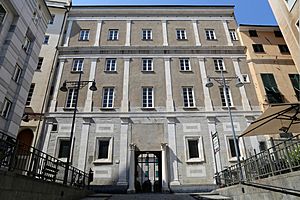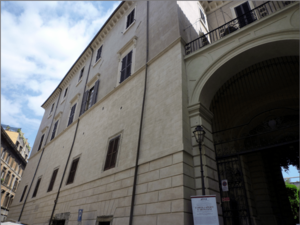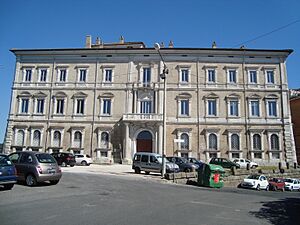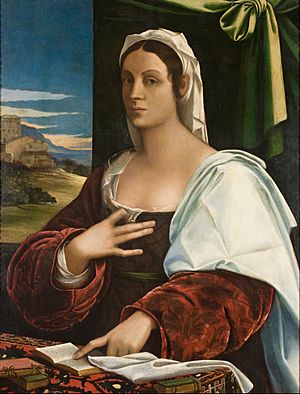Felice della Rovere facts for kids
Quick facts for kids
Felice della Rovere
|
|
|---|---|
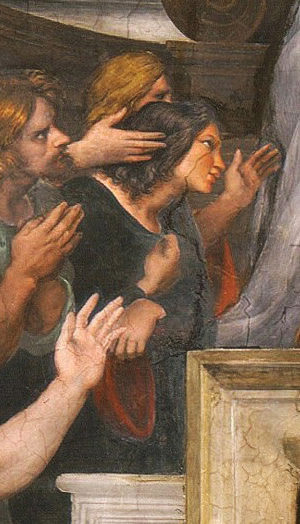
Felice portrayed by Raphael in The Mass at Bolsena (1511), as identified by Murphy
|
|
| Born | c. 1483 |
| Died | 27 September 1536 (aged 52–53) Rome, Papal States
|
| Spouse(s) |
Gian Giordano Orsini
(m. 1506; |
| Children | Giulia Giulio Francesco Girolamo Clarice |
| Parents |
|
| Top - 0-9 A B C D E F G H I J K L M N O P Q R S T U V W X Y Z |
Felice della Rovere (around 1483 – 27 September 1536), also known as Madonna Felice, was the daughter of Pope Julius II. She was one of the most powerful women during the Italian Renaissance.
Felice was born in Rome around 1483. Her mother was Lucrezia Normanni, and her father was Cardinal Giuliano della Rovere, who later became Pope Julius II. Felice received a good education. She became friends with important noble families and also with scholars and poets because she loved learning.
Thanks to her father's influence, including an arranged marriage to Gian Giordano Orsini, Felice gained great wealth and power. She even helped make peace between her father and the Queen of France. After her husband died in 1517, she became the head of the Orsini family for over ten years. Felice also increased her power by buying a castle called Palo and by getting involved in the grain trade.
Felice had two sons who survived, Francesco and Girolamo. She chose Girolamo to inherit the Orsini family's wealth. She also had two daughters, Giulia and Clarice. Her children married into very important families like the Colonna and Sforza. Felice's family line, the dukes of Bracciano, continued until 1699.
Her legacy lives on today. A scholar named Caroline Murphy has identified Felice in two famous artworks: Raphael's The Mass at Bolsena and a portrait by Sebastiano del Piombo. Felice also wrote letters to other famous people of her time, like Catherine de' Medici.
Growing Up
We don't know the exact date Felice della Rovere was born, but it was likely in Rome around 1483. Her mother, Lucrezia Normanni, came from a very old Roman family. Her father, Giuliano della Rovere, was born in a coastal village. Before becoming pope, he was an Archbishop.
Felice grew up with two half-siblings, Gian Domenico and Francesca. They were born after her mother married Bernardino de Cupis. Her stepfather worked for a cardinal and was well-paid, so Felice and her family lived comfortably.
Felice spent her early years in the de Cupis Palace in Piazza Navona in Rome. In 1494, her father tried to remove Pope Alexander VI from power. To keep Felice safe from danger, she was moved from Rome to the Palazzo della Rovere in Savona.
Her Education
Felice grew up in a busy part of Rome, surrounded by important people like businessmen and lawyers. As she got older, she became very interested in learning about humanism, which was a popular way of thinking at the time. She made friends with scholars and poets who visited the Vatican.
A philosopher and poet named Giovanni Filoteo Achillini wrote a poem praising Felice. She also became close with Scipione Carteromacho, a scholar who helped her get many books in Latin and Italian. Felice loved to read and had a large collection of books.
She owned old manuscript books and many other books, even if they weren't worth much money. It's thought that her love for learning helped her become accepted by powerful families like the Medici and Gonzaga.
First Marriage
When Felice was about 14 or 15 years old, her father arranged for her to marry. We don't know who her first husband was, but he was probably from Savona or Genoa. He likely had strong political connections that would have helped her father.
This marriage was short. The man died in early 1502, and the reasons are unknown. This experience probably made Felice not want to marry again. After his death, she turned down many possible husbands, including one her father liked.
When her first husband died, Felice likely received her dowry back. This money gave her financial freedom as long as she stayed unmarried. This might have been a reason why she was hesitant to marry again.
Second Marriage
After becoming pope in 1503, Pope Julius II wanted to find Felice a second husband. This was hard because Felice was not a popular choice. She was the daughter of a pope, and she was already 20 years old, which was considered old for marriage at that time.
Eventually, a match was made with Gian Giordano Orsini. He was the leader of two of Rome's most powerful noble families. This was a great match for Felice because it meant she could stay in Rome. It also helped Pope Julius II end a long-standing feud between the Orsini and Colonna families. He did this by marrying his niece into the Colonna family and Felice into the Orsini family.
Gian Giordano was 20 years older than Felice. He had been married before and had three children. Felice's dowry was 15,000 ducats. Pope Julius II didn't want to seem like he was favoring his family too much, so he didn't allow big celebrations for Felice's wedding and didn't even attend. The wedding took place on May 24 and 25, 1506, at a palace that was in disrepair.
Some historians thought the marriage was unhappy. They claimed Gian Giordano made fun of Felice for being the pope's daughter. However, evidence suggests that Gian Giordano grew to like Felice's "managerial qualities and diplomatic skills." He encouraged her to follow her goals. In the first two years of her marriage, Felice's main goal was to have a son. A son would secure her place in the Orsini family and make her the head of the family if Gian Giordano died while her son was young.
Making Up with Her Father
When Pope Julius II didn't attend Felice's wedding, she felt disrespected and upset with him. This caused a disagreement between them for a few months. To make amends, Julius II invited Felice and her new husband to the Vatican in June 1506. He held a grand dinner in their honor.
After this, Julius II often made Felice the special guest at parties in Rome. She was often the only woman there. Being at these events helped Felice gain power within the Vatican court. The Pope also gave Felice expensive jewelry and large sums of money. One of her most treasured gifts was a diamond cross that her father had received from the Republic of Venice.
Her Business Activities
The Castle at Palo
During her marriage, Felice gained her own money and property, which made her a rich woman. Her main source of income was the estate and castle at Palo, located near modern-day Ladispoli. She bought this castle in 1509. It gave her income and helped her increase her family's power.
She made the castle a papal residence, meaning popes would stay there. Her father, Pope Julius II, gave it this status, and it continued even after he was no longer pope. Later popes, like Pope Leo X, were guests at the castle. The land around Palo was good for hunting, which attracted these important guests. It eventually became an official papal hunting lodge.
Felice made a deal with Leo X to turn the castle into a luxury property. He agreed to pay for the needed repairs and upgrades. In return, Felice let Leo X stay at Palo for free. By using the castle as a financial asset and hosting important guests, Felice improved her own image and that of the della Rovere family.
Grain Trade
Besides owning property, Felice also earned money from the grain trade. This business experience helped her financially during her marriage and after her husband's death. The fields on her Palo property were perfect for growing wheat, producing a lot of grain.
However, during a grain shortage in Rome in 1533–1534, Felice's income suffered. Bad weather and poor transportation caused the crisis. Rome had to import grain, which doubled its price. Since Felice sold her grain locally, she was affected by the bad harvest. She had to bargain to get a better price for her grain. This showed Felice's strong will, as haggling was not typical for upper-class women. Despite these challenges, Felice successfully used the grain trade to increase her wealth.
Role in Peace Talks
In 1510, during the Italian Wars, Pope Julius II wanted France out of Northern Italy. He ended an alliance with France and formed a new one, the Holy League, with Venice. This made tensions rise between Julius II and Louis XII.
After the Papal States lost a city to France, Julius II agreed to talk peace. Felice's husband, Gian Giordano Orsini, was part of these talks. Julius II sent Felice to France in July 1511. For two years, she was involved in negotiations with Queen Anne of Brittany.
Her Children
Felice and Gian Giordano had five children, and four of them lived to adulthood. Felice was a very involved mother. She named her children, which was usually done by godparents. She also hired their wet nurses and managed their money. She was mainly responsible for raising her sons, Francesco and Girolamo, who were four and five when their father died in 1517.
Felice had three sons and two daughters:
- Giulia Orsini (1507–1537). She married Pietro Antonio Sanseverino in 1521 and had two daughters.
- Giulio Orsini (August 1508–1508). He lived only a few months.
- Francesco Orsini (17 May 1512– April 1560). He was a Bishop.
- Girolamo Orsini (7 July 1513– 3 November 1540), who became the Lord of Bracciano. He married Francesca Sforza. They had a daughter, Felicia, and a son, Paolo Giordano I Orsini. Girolamo died from injuries after an attack.
- Clarice Orsini (1514–before 1562). She married Luigi Carafa della Stadera.
Relationship with Her Stepson Napoleone
Some members of the Orsini family saw Felice as an "evil stepmother." This was because her sons would inherit the family fortune instead of Napoleone, Gian Giordano's son from his first marriage. Felice helped Napoleone become an abbot and get extra income.
However, Felice thought Napoleone was aggressive. She feared he might harm her sons to get the inheritance back. To protect her children, Felice kept Napoleone at a distance. Napoleone was later killed by his half-brother Girolamo in 1534.
Arranging Marriages
As the head of the Orsini family, Felice helped arrange marriages for her stepchildren and her own children. In 1519, she arranged for her stepdaughter Carlotta to marry Giantommaso Pico. Felice needed approval from Napoleone and other Orsini men for this.
Then, Felice arranged for her daughter Giulia to marry Pietro Antonio di Sanseverino. They agreed on a large dowry. This marriage helped Felice gain money and a strong ally. However, it also upset some Orsini family members and Napoleone.
After a major event called the Sack of Rome, Felice arranged for Clarice to marry Don Luigi Carafa. His family was friendly with the Spanish, giving Felice an important ally. Felice also arranged for Girolamo to marry Francesca Sforza, though this happened after Felice's death.
Becoming a Widow
In September 1517, Gian Giordano became ill. He made a will, giving Felice the power to act as the head of the Orsini family after his death. This was to happen while their sons were still young. One of Gian Giordano's staff members wrote that Gian Giordano said Felice deserved this honor because she was a good wife.
This announcement was made publicly so that the Orsini family couldn't argue against Felice becoming the head of the estate. Gian Giordano died on October 11 at his castle. He left all his possessions to his sons. Felice's new role made her one of the most powerful people in Rome. Scholars say her education prepared her well for this. Pope Leo X confirmed her position, stating she would be the guardian of Gian Giordano's children as long as she remained a widow.
There were some rumors about Gian Giordano's death. Some thought Felice might have been responsible. Some Orsini family members supported Napoleone as the rightful leader. However, Pope Leo X supported Felice, and there was no proof of any suspicious activity.
The Sack of Rome
In 1527, Felice was not at the Orsini Palace when the Sack of Rome began. This likely saved her life, as it was one of the first palaces attacked. She and her children were with her mother and half-siblings at another palace. They decided it was safest to split up by gender and flee Rome.
The women dressed in simple clothes, hid their jewels, and went to a rented castle. This castle gave shelter to many noblewomen and noblemen. It was one of the only palaces not attacked because the owner's son was leading the attack. The palace was soon held for ransom. Felice paid for herself and others, including her nephew.
Felice and her family then fled Rome by boat. The family split up again because Felice wanted to be far from Rome. She wanted to protect her children from Napoleone, who was at her Bracciano estate. Felice feared Napoleone might use the chaos to kill her sons and reclaim the Orsini lordship.
Felice and her children stayed with her cousins in the Duchy of Urbino. There, she received a palace in a hillside town. From there, Felice helped noblemen and women in Rome by sending money and supplies.
The Sack of Rome ended in 1528, but Felice didn't return immediately. Napoleone was still fighting near Bracciano. Once Napoleone was gone, Felice felt safe returning. Back in Rome, Felice had the Orsini estate rebuilt for her sons and the family's reputation. Her other property was also destroyed, so she had it rebuilt. The Sack of Rome greatly changed Felice's life, and for the first time, she was poor.
In Art
No official portrait of Felice has been found. However, Caroline Murphy suggests two artworks might show her. These are Raphael's The Mass at Bolsena and Sebastiano del Piombo's portrait of an unknown woman.
The Mass at Bolsena was ordered by Julius II in 1512. It shows the miracle of Bolsena. Since Julius II was Raphael's patron, he likely influenced who appeared in the painting. The painting includes clergy and male members of the della Rovere family, plus a few women. Murphy believes the kneeling woman in black, looking up at Julius II, is Felice. She looks different from the other women, who seem more stylized.
Sebastiano del Piombo was another painter of that time. He was known to Felice. The similar clothing in his portrait and The Mass at Bolsena led Murphy to suggest it's also Felice. Her presence in these artworks isn't fully confirmed. But since Julius II supported the arts, it's likely he included his daughter in some of the paintings he commissioned.
Her Legacy
Felice is not as famous as some other women of her time, like Lucrezia Borgia or Isabella d'Este. However, she was a respected figure during her life. She knew other important people of the 1500s, such as Catherine de' Medici and Pope Leo X. Even though there isn't a lot of information about her life, it's clear she wrote to many important figures.
Catherine de' Medici, who became Queen of France, stayed with Felice as a young child. Later, she wrote a letter thanking Felice for her care. This letter shows Felice's good reputation. Felice also corresponded with Pope Leo X, who became pope after her father. Her good standing with high-ranking people is clear from her business dealings with Leo X and her hosting him at her home.
Her reputation is also mentioned in a book called History of the House of Orsini. It says that Felice's granddaughter shared her grandmother's name and good manners.
Sources
- Bedini, Silvio A., and Fundação Calouste Gulbenkian (1997). The Pope's Elephant. Manchester: Carcanet Press Ltd. ISBN: 978-1-85754-277-6.
- Cummings, Anthony M. (2012). Pope Leo X, the Renaissance Papacy, and Music. Ann Arbor: University of Michigan Press. ISBN: 978-0-472-11791-8.
- Hirst, Michael (1981). Sebastiano del Piombo. Oxford: Clarendon Press. ISBN: 978-0-19-817308-3.
- Jones, Roger and Nicholas Penny (1983). Raphael. New Haven and London: Yale University Press. ISBN: 978-0-300-04052-4.
- Shaw, Christine (1993). Julius II, The Warrior Pope. Cambridge, USA: Blackwell. ISBN: 978-0-631-16738-9.


